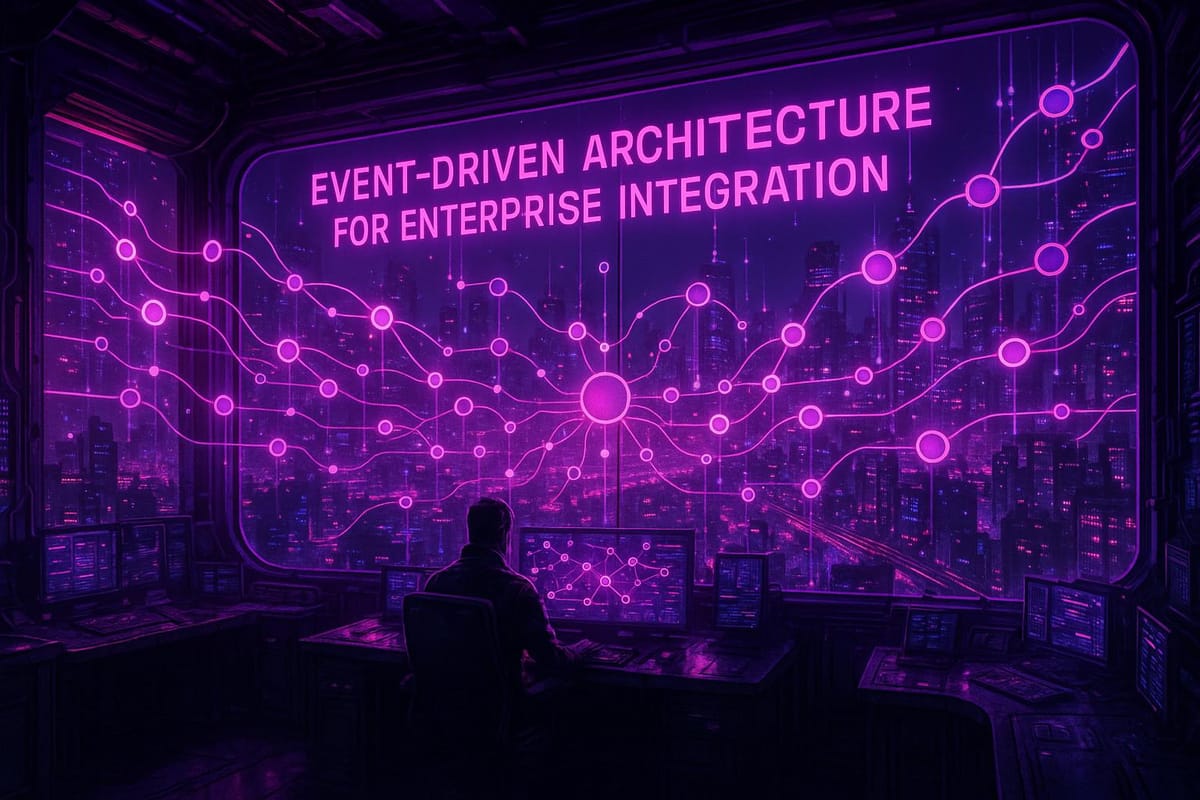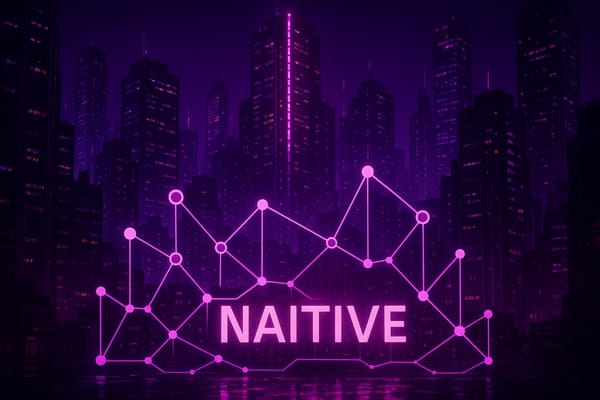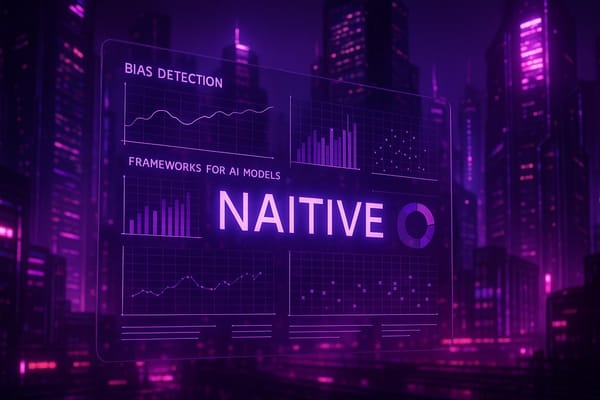Event-Driven Architecture for Enterprise Integration
Event-Driven Architecture revolutionizes enterprise integration with real-time responsiveness, scalability, and resilience, surpassing traditional methods.

Event-Driven Architecture (EDA) is transforming how businesses manage system integrations. Unlike older methods that rely on direct connections or scheduled data transfers, EDA uses real-time events to enable systems to communicate efficiently. This approach offers better scalability, faster processing, and improved resilience, making it an excellent choice for modern enterprises. Here's why EDA stands out:
- Scalability: Handles high data volumes with ease by allowing components to scale independently.
- Resilience: Decoupled systems ensure failures in one area don’t disrupt the entire system.
- Real-Time Processing: Enables immediate responses, perfect for time-sensitive tasks like fraud detection.
- Simplified Integration: Reduces complexity by using a centralized event infrastructure instead of multiple point-to-point connections.
In contrast, older integration methods often struggle with scalability, are prone to cascading failures, and rely on batch processing, which delays data updates. While they may work for stable workflows, they lack the flexibility and speed required for today’s dynamic business needs.
Quick Comparison:
| Criteria | Event-Driven Architecture | Older Integration Methods |
|---|---|---|
| Scalability | High, with independent scaling | Limited, prone to bottlenecks |
| Resilience | Isolated failures | Cascading failures possible |
| Processing Speed | Real-time | Delayed, batch-based |
| Integration Effort | Simplified | Complex, custom connections |
| Maintenance | Easier with decoupled systems | High due to tightly coupled systems |
EDA is ideal for businesses prioritizing speed, flexibility, and reliability in their operations. If your organization is navigating complex digital ecosystems, transitioning to EDA could streamline processes and prepare you for future growth.
Enterprise Service Bus v Event-Driven Architecture
1. Event-Driven Architecture (EDA)
Event-Driven Architecture (EDA) changes the way enterprises manage communication by using events to trigger real-time, scalable, and resilient integrations. Instead of relying on direct, hardwired connections between systems, EDA uses events - essentially notifications that something important has occurred - as the core method of communication. These events move through message brokers or event streaming platforms, creating a flexible system where components can evolve independently while still working together seamlessly.
At its heart, EDA is straightforward: when something happens in one part of the system, it sends out an event, and other parts of the system react to it.
Scalability
One of EDA's standout features is its ability to handle increasing workloads with ease. Its design allows individual components to scale independently based on demand. For example, when event volumes spike, more consumers can be added in parallel without disrupting the system's overall performance. Thanks to its asynchronous nature, producers and consumers operate independently, making it ideal for businesses dealing with unpredictable traffic patterns or seasonal surges. This flexibility also naturally supports system resilience, which we’ll dive into next.
Resiliency
EDA's decoupled structure makes it incredibly resilient. If a component fails to process an event, the rest of the system keeps running smoothly while the issue is addressed. Failed events can be retried or handled separately, and services can restart on their own, replaying events to recover without manual intervention. Persistent queues ensure "Guaranteed Delivery", meaning temporarily unavailable systems can process events once they’re back online. Durable event stores also provide detailed audit trails, helping teams troubleshoot, recover, and restore systems to a consistent state after failures.
To build systems that can gracefully handle unexpected issues, teams can use techniques like shuffle sharding to isolate workloads or customer segments. This limits the impact of failures, ensuring that one problematic event doesn’t disrupt the entire system. Queues and buffers can also absorb sudden traffic spikes, offering retry and replay functions while protecting the system from overload.
Latency
EDA also excels at reducing delays, enabling near real-time processing. Unlike traditional batch systems that wait for scheduled synchronization, EDA allows events to flow continuously. This makes it perfect for time-sensitive tasks like fraud detection, inventory updates, or enhancing customer experiences. For workloads that can’t afford delays, businesses can pre-allocate resources for critical operations and use autoscaling with provisioned concurrency to maintain efficiency during traffic spikes. Adopting "Fail Fast" principles ensures that consumers quickly identify and resolve issues, preventing prolonged delays and allowing systems to recover more efficiently.
Simplifying Integration
Another advantage of EDA is how it simplifies system integration. While it introduces new concepts and tools, it eliminates the need for numerous point-to-point connections. Instead, a centralized event infrastructure handles message routing and delivery. By standardizing event formats, organizations can ensure consistency across applications, making it easier to add new producers or consumers without disrupting existing systems.
However, successful implementation requires careful planning. Teams need to focus on event schema design, manage message ordering, and handle eventual consistency challenges. Strategies like bounded retries with exponential backoff and jitter can prevent endless retry loops, while robust observability practices help track key metrics like failure detection, recovery time, and the extent of system impact.
For businesses looking to implement EDA effectively, NAITIVE AI Consulting Agency offers expert guidance in designing and managing cutting-edge integration solutions that leverage modern AI and automation technologies.
2. Traditional Integration Methods
While Event-Driven Architecture (EDA) shines with its flexibility and real-time responsiveness, traditional integration methods reveal several limitations that make them less suited for today's fast-paced demands. These older approaches, though widely used in the past, often fall short when agility and real-time processing are essential. Typically, they rely on direct system-to-system connections, batch processing, and centralized middleware platforms. This contrast underscores why traditional methods struggle where EDA excels.
Scalability
Traditional systems were built for a fixed scale of operations, making it difficult to handle growing data volumes or an increasing number of integrations without significant upgrades. As businesses adopt more applications and data sources, the infrastructure often buckles under the pressure, leading to slowdowns and bottlenecks.
Point-to-point integration is a major culprit here. Each new application requires its own connection to every system it interacts with, creating a tangled web of dependencies that becomes nearly impossible to manage.
Even hub-and-spoke models, which are more structured than point-to-point setups, have their flaws. The central hub can become a bottleneck or even a single point of failure as data traffic and the number of connections rise. Similarly, Enterprise Service Buses (ESBs), while more advanced, can struggle to handle large volumes of data or simultaneous connections, eventually leading to performance issues.
Resiliency
One of the biggest drawbacks of traditional methods is their tightly coupled nature. A failure in one part of the system can quickly cascade, affecting other connected systems. Hub-and-spoke models are particularly vulnerable since the central hub represents a single point of failure.
Latency
Compared to EDA's near-instant responsiveness, traditional methods often lag. Network delays become especially noticeable when integrating cloud services across various regions or transferring large datasets between on-premises and cloud systems. These delays can severely impact real-time analytics and degrade user experiences.
"These older systems were not built for the scale and agility required today. They often lack the flexibility to adapt to new technologies and can't provide the real-time data syncing necessary for timely decision-making."
Legacy systems often make latency issues worse. Many rely on outdated data formats and lack modern APIs, making data extraction a slow and cumbersome process.
Batch processing is another common limitation of traditional platforms. Instead of enabling real-time data flows, these systems depend on scheduled synchronization windows. This delay in information updates can hinder timely decision-making. As data volumes grow, these delays become even more problematic. Additionally, network congestion or performance fluctuations can trigger unpredictable latency spikes, further affecting system responsiveness and throughput.
Integration Complexity
As organizations grow, traditional integration methods tend to introduce more complexity. Point-to-point connections require custom development for each integration. Any changes in a system's interface or data format can trigger a cascade of updates across multiple connection points, creating a web of dependencies that becomes increasingly difficult to maintain.
Middleware platforms help to some extent by offering standardization, but they still require setup and customization for each specific use case. The lack of uniform event formats across systems often means that every integration becomes a highly tailored project requiring specialized expertise and ongoing maintenance.
Legacy systems add yet another layer of difficulty. They frequently rely on proprietary protocols and data formats that don't align with modern integration standards. This forces businesses to develop custom translation layers, increasing both development time and the risk of errors.
Advantages and Disadvantages
When comparing Event-Driven Architecture (EDA) with traditional integration methods, it's essential to weigh their strengths and limitations. Both approaches offer distinct benefits and challenges that can shape your enterprise integration strategy.
| Criteria | Event-Driven Architecture | Traditional Integration Methods |
|---|---|---|
| Scalability | Handles increasing data volumes and connections through loose coupling and distributed processing | Struggles to scale due to fixed infrastructure and point-to-point dependencies that create bottlenecks |
| Resiliency | Ensures system stability by isolating failures in decoupled components | Susceptible to cascading failures because of tight coupling and single points of failure |
| Latency | Enables near real-time processing with immediate event propagation | Experiences delays due to batch processing, network overhead, and scheduled synchronization |
| Integration Complexity | Simplifies adding new systems with standardized event formats and loose coupling | Becomes increasingly complex as each new integration requires custom development |
| Development Speed | Speeds up development with reusable event handlers and standardized interfaces | Slows down development with custom coding for each integration point |
| Maintenance | Lowers maintenance needs by allowing independent updates to components | Demands significant maintenance as changes ripple through tightly coupled systems |
Practical Implications
EDA stands out when it comes to scalability and resiliency. Its loosely coupled components allow for seamless updates without disrupting the entire system, and its distributed structure minimizes the risk of widespread failures. Additionally, EDA excels in real-time processing, making it ideal for scenarios where immediate responsiveness is critical.
Despite its advantages, EDA is not without challenges. Debugging across multiple services can be complex, and its reliance on eventual consistency can pose issues for applications requiring strict data synchronization.
On the other hand, traditional integration methods offer predictability and simplicity. Their linear workflows make debugging straightforward, and their established frameworks often reduce the learning curve for teams. However, as systems grow, these methods reveal their limitations. Scalability becomes a significant hurdle, with central hubs or middleware struggling to manage increasing loads. Moreover, adapting to new business needs often demands extensive rework due to their rigid architecture.
Cost Considerations
Cost is another critical factor. While EDA typically requires a higher initial investment, it often leads to long-term savings through reduced maintenance and greater flexibility. Traditional methods, however, may seem less expensive upfront but can incur higher maintenance costs over time due to their tightly coupled nature.
Choosing the Right Approach
Ultimately, the decision between EDA and traditional methods depends on your organization's priorities. If agility, real-time processing, and scalability are top of mind, EDA is likely the better choice. For businesses with stable, predictable workflows, traditional methods might suffice.
For companies embracing AI and automation, EDA's real-time capabilities provide the backbone for responsive AI systems and seamless automation, making it a strong contender for driving digital transformation efforts.
Conclusion
Event-Driven Architecture (EDA) offers a clear edge over traditional integration methods, especially for modern enterprises. With its ability to scale effortlessly, process data in real-time, and maintain resilience, EDA addresses the challenges that rigid, tightly coupled systems often face as businesses expand. Its loosely coupled design ensures the flexibility and adaptability needed to thrive in competitive environments.
By leveraging EDA, organizations can achieve faster development cycles, reduced maintenance costs, and enhanced system reliability - all of which contribute to greater operational efficiency and a lower total cost of ownership. These benefits underscore why EDA is not just a better choice but a strategic one for enterprises aiming to modernize their integration approach.
Making the Transition
To adopt EDA successfully, start by identifying high-impact areas where real-time processing and scalability are critical. Common pain points, like synchronizing customer data or managing inventory across multiple platforms, are prime candidates for an EDA-driven approach.
For a seamless transition, ensure that your technical architecture aligns closely with your core business processes. This alignment becomes even more crucial when integrating advanced technologies like AI and automation, which can fully utilize EDA's responsive and dynamic foundation.
If your organization is exploring AI-driven solutions within an event-driven framework, consulting experts can make a significant difference. NAITIVE AI Consulting Agency specializes in creating autonomous AI agents, voice automation systems, and business process automation tailored to EDA's real-time capabilities. Their expertise in delivering measurable results makes them an excellent partner for enterprises looking to blend EDA with cutting-edge AI technologies.
EDA represents the future of enterprise integration. Businesses that embrace this approach today will be better equipped to tackle tomorrow's challenges while reaping immediate rewards in scalability, resilience, and efficiency. By adopting EDA, organizations can establish a forward-thinking integration strategy that sets the stage for long-term success.
FAQs
How does Event-Driven Architecture help systems scale more effectively than traditional methods?
Event-Driven Architecture (EDA) enhances scalability by allowing system components to function independently and adjust their capacity based on the number of events they handle. This approach ensures that as demand rises or falls, the system can adapt in real time without disrupting other parts of the architecture. The result? Consistent performance, even during traffic surges or sudden data spikes.
Traditional integration methods often require scaling the entire system, which can be both expensive and inflexible. In contrast, EDA’s loosely coupled design offers a more efficient and flexible solution, making it especially valuable for organizations dealing with unpredictable workloads or rapidly increasing data demands.
What challenges might businesses face when switching from traditional integration methods to event-driven architecture?
Transitioning to an event-driven architecture (EDA) comes with its fair share of challenges. One of the biggest hurdles is managing the growing complexity of event flows as systems expand. As the number of events and interactions increases, debugging and troubleshooting can become much trickier, requiring more effort to pinpoint and resolve issues.
Another critical concern is event reliability. Without the right safeguards in place, there’s a real risk of losing events or encountering inconsistencies across the system - issues that can disrupt operations and impact user experience.
Integrating EDA with existing systems and processes is no small feat either. It often demands substantial time, resources, and expertise to ensure everything works seamlessly. On top of that, teams may need to familiarize themselves with new tools and frameworks, which can involve a steep learning curve. However, with careful planning and a phased approach, businesses can navigate these challenges and set themselves up for long-term success.
How does Event-Driven Architecture enhance AI and automation in enterprises?
Event-Driven Architecture (EDA) plays a key role in boosting AI and automation within businesses by enabling systems to react to events as they happen. This capability allows organizations to build flexible and efficient workflows where AI can adapt in real time to challenges like supply chain disruptions or shifts in demand.
EDA also simplifies how systems interact, ensuring AI tools and automation platforms work smoothly together. Its scalable and durable framework supports the rollout of autonomous AI agents and automated processes, helping businesses streamline operations, make faster decisions, and minimize delays.




